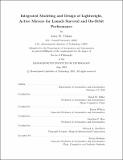Integrated modeling and design of lightweight, active mirrors for launch survival and on-orbit performance
Author(s)
Cohan, Lucy Elizabeth
DownloadFull printable version (7.825Mb)
Other Contributors
Massachusetts Institute of Technology. Dept. of Aeronautics and Astronautics.
Advisor
David W. Miller, Karen Willcox, Jonathan P. How and Howard A. MacEwen.
Terms of use
Metadata
Show full item recordAbstract
Lightweight, active mirrors are an enabling technology for large aperture, space-based optical systems. These mirrors have the potential to improve the optical resolution and sensitivity beyond what is currently possible. However, as with all technology development programs, there are remaining issues to be solved before such mirrors can be used in operational systems. As of yet, no efforts have been made to explore the design space or optimize the design of lightweight mirrors across operational environments and constraints. The extremely harsh launch environment is of particular concern because launch survival constraints could dictate aspects of the mirror design. Additionally, on-orbit optical performance, in terms of high spatial frequency wavefront error and low spatial frequency correctability, are extremely important aspects of mirror design. Due to the lack of heritage systems, the best designs for lightweight, active mirrors are not immediately apparent. Therefore, an integrated modeling methodology for technology development programs is developed. This framework uses model-based design and evolutionary models to guide the technology development program. This methodology is applied to the lightweight, active mirror systems of interest. The mirrors are modeled and analyzed in two distinct environments: on-orbit and during launch. The on-orbit model and analysis are presented, as well as the designs with the best optical performance, which tend to have many ribs and actuators. Additionally, a dynamic state-space model of the launch environment is developed. The designs that are most likely to survive launch have few ribs and actuators, directly in conflict with the best on-orbit designs. Launch load alleviation techniques, including techniques making use of the existing embedded actuators, are also implemented to increase the probability of launch survival. Finally, a fully integrated trade space analysis of designs is shown, along with families of designs that perform well with respect to different mission objectives. The integrated modeling approach allows for the seamless combination of the two analysis, as well as a way in which to determine the best performing designs. By using this approach, the model can be updated to include any new insights and to reflect the current state of the technology, making it useful throughout the life cycle of the program.
Description
Thesis (Ph. D.)--Massachusetts Institute of Technology, Dept. of Aeronautics and Astronautics, 2010. This electronic version was submitted by the student author. The certified thesis is available in the Institute Archives and Special Collections. Cataloged from student submitted PDF version of thesis. Includes bibliographical references (p. 241-256).
Date issued
2010Department
Massachusetts Institute of Technology. Department of Aeronautics and AstronauticsPublisher
Massachusetts Institute of Technology
Keywords
Aeronautics and Astronautics.